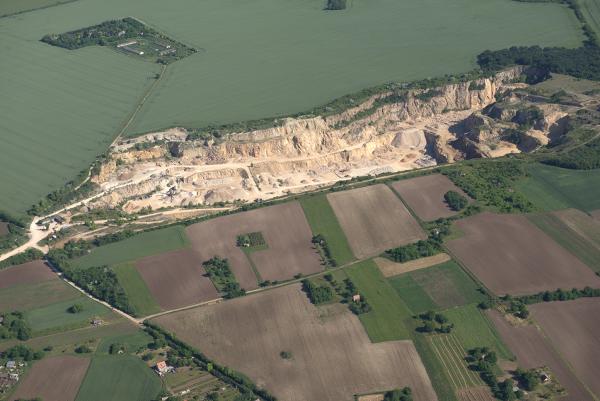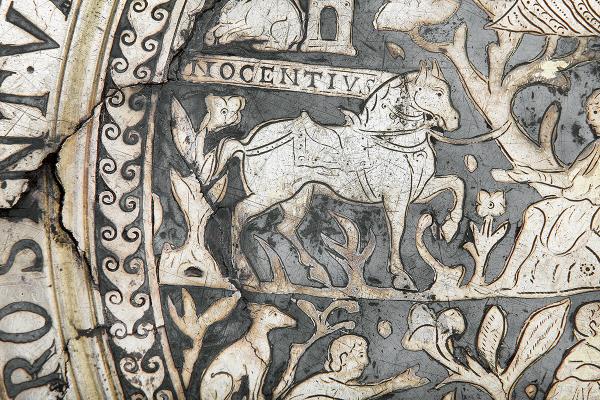Archaeological issues
Archaeological research concerning the Seuso treasure includes research into identifying the location where the treasure was hidden; research of its presumed place of use, the settlement history and topography of the owner’s or owners’ residence; archaeological excavations to throw light on the imperial connections of the Seuso treasure in the Hungarian territory of Pannonia; the examination of the shape of its vessels and their function, as well as of the Seuso treasure as a treasure find. Field archaeological explorations are taking place in four main areas. One of their main aims is to explore the place for temporarily hiding the Seuso treasure and the findspot of the silver stand, which is presumed to have belonged to the treasure. As part of that, geophysical research and excavations were undertaken on Szár Hill of Kőszárhegy. On the one hand, they concerned the so-called Borbély vine cellar and its direct vicinity and, on the other, the identification of the findspot of the Kőszárhegy silver stand. The stand probably used to be part of the Seuso treasure, thus the scene of where it was found is not independent of the place where the treasure was hidden. One of the principal results of our research is that we succeeded in proving that the Roman hiding place of the silver stand was in the immediate vicinity of the temporary, 20th-century hiding place of the Seuso treasure (the present Borbély cellar). The comprehensive micro-regional research of the area between Sárvíz, Sárrét and Lake Balaton also takes place with the aim of examining the late Roman settlement history of the broader vicinity of Szár Hill. Seuso’s estate could have covered that area, so learning about the narrower region can take us closer to him and his family. With the help of aerial photography, archaeological excavations and geophysical research, as well as field survey, several significant late Roman sites and so far unknown villas have been identified successfully. However, determining their connection with the Seuso treasure, its former owners and their estates still requires further field explorations. In addition, we are looking for archaeological traces referring to large estates and later Roman luxury villas around Lake Balaton, primarily on its northern side. Their existence in fact proves the popularity of the lake among the late imperial provincial elite. In order to understand the Roman imperial cultural milieu of the treasure, excavations have begun on the site of the late Roman luxury villa of Nagyharsány, South Hungary.
With its enormous banquet hall and apse decorated with high quality artistic mosaics with glass tesserae (city personifications, animal fights and marine scenes, Greek mythological stories including Aphrodite’s beautification), and with the owner of the villa being the former governor of province Gallia Lugdunensis III, Valerius Dalmatius, it is the only site in Hungary that can be surely identified which provides the opportunity for us to have an image of the way of life and the luxury of the landowners who belonged to the circle of the imperial elite.
A Pannonian member’s lifestyle and household belonging to the imperial elite can be better understood as a result of the archaeological excavation of the villa. With its help the Szabadbattyán complex of buildings with its disputed function can be interpreted.


Analysis of the shapes of the treasure’s vessels and their function has also been included in the archaeological research. In addition, the influence of the design of the vessels made from precious metals on vessels of other materials (ceramic, glass, bronze) is also examined. Research involves the analysis of objects of everyday use, weapons and clothing with an archaeological approach. Thus, for example, identification of the tools used for weaving that can be seen in the medallion of the Achilles platter is taking place. The description and analysis with an archaeo-zoological approach of animals appearing on the rim and in the medallion of the Seuso platter have achieved new results. The evaluation of the Seuso treasure as a treasure find and its comparison with similar finds are significant tasks. The archaeological analysis of the Seuso treasure as an entire single treasure find also extends to the composition of the find as a whole, the way and circumstances of its hiding and its comparison with treasure hoards of similar age and composition discovered within and outside the later Roman Empire.
Head of the sub-project: Zsolt Mráv, archaeologist, chief curator of the Hungarian National Museum, head of the Roman Collection, deputy director of the Department of Archaeology


